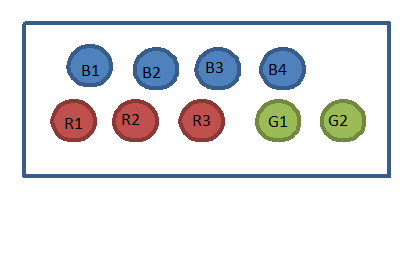Unit 2 Probability
3.3 The Addition Rule
Compound Events: Combining two or more simple events.
Mutually Exclusive (or Disjoint) events: Compound events that CANNOT OCCUR at the same time

The Addition Rule: Probability of Event A OR Event B occurring.
\(P(A \text { or } B)=P(A)+P(B)-P(A \text { and } B)\)
- In our bag of poker chips, what was P(B)? P(1)? What is P(Blue or 1)?
\(P(B)=\frac{4}{9}\)
\(P(1)=\frac{3}{9}\)
To calculate P(Blue or 1), we will need P(Blue and 1):
\(P(\text {Blue } \text {and } 1)=\frac{1}{9}\) \(P(B \text { or } 1)=P(B)+P(1)-P(B \text { and } 1)=\frac{4}{9}+\frac{3}{9}-\frac{1}{9}=\frac{6}{9}\)
- Let's roll 2 six-sided dice.
n(S) = 36 1 1 1 2 1 3 1 4 1 5 1 6 2 1 2 2 2 3 2 4 2 5 2 6 3 1 3 2 3 3 3 4 3 5 3 6 4 1 4 2 4 3 4 4 4 5 4 6 5 1 5 2 5 3 5 4 5 5 5 6 6 1 6 2 6 3 6 4 6 5 6 6
- P (sum of 3) =
\(\frac{2}{36}=.056\)
- P (sum of 7) =
\(\frac{6}{36}=.167\)
- P (sum of 1) =
\(\frac{0}{36}=0\)
- P (sum < 13 ) =
\(\frac{36}{36}=1\)
- P (first die is 3) =
\(\frac{6}{36}=.167\)
- P(second die is 5) =
\(\frac{6}{36}=.167\)
- P (first is a 3 or second is a 5) =
\(\frac{6}{36}+\frac{6}{36}-\frac{1}{36}=\frac{11}{36}\)
- P (sum of 3) =
- With a standard deck of cards and a fair die, find the following probabilities:
- P(draw a heart and roll a 3)
- P(draw a face card and roll an odd number)
- P(draw a jack, given that you draw a face card)
- P(draw a heart or roll a three)
- P(draw a red or draw a ten)
- P(draw a king or draw a diamond)
\(\frac{13}{52} \cdot \frac{1}{6}=\frac{13}{312}=.0417\)
\(\frac{12}{52} \cdot \frac{3}{6}=\frac{36}{312}=.1154\)
\(\frac{4}{12}=.333\)
\(\frac{13}{52}+\frac{1}{6}=.417\)
\(\frac{26}{52}+\frac{4}{52}-\frac{2}{52}=\frac{28}{52}=.5382\)
\(\frac{4}{52}+\frac{13}{52}-\frac{1}{52}=\frac{4}{13}=.3077\)
- In a bag, you have
4 blue chips numbered 1, 2, 3,and 4
3 red chips numbered 1, 2, and 3
2 green chips numbered 1 and 2.

You randomly select one chip from the bag. Find:
- P (blue or red)
\(P(B)+P(R)-P(B \text { and }R)=\frac{4}{9}+\frac{3}{9}-\frac{0}{9}=\frac{7}{9}=.7778\) B and R are disjoint events. - P (blue or 3)
\(P(B)+P(3)-P(B \text { and }3)=\frac{4}{9}+\frac{2}{9}-\frac{1}{9}=\frac{5}{9}=.5556\) - P (red or 3)
\(P(R)+P(3)-P(R \text { and }3)=\frac{3}{9}+\frac{2}{9}-\frac{1}{9}=\frac{4}{9}=.4444\) - P (green or 3)
\(P(G)+P(3)-P(G \text { and }3)=\frac{2}{9}+\frac{2}{9}-\frac{0}{9}=\frac{4}{9}=.4444\)
- P (blue or red)
- The following table gives the number of people with health insurance coverage in the U.S. in 2018. Note that the numbers are in millions of people.
Source of data
(In millions) Private insurance Private insurance (Marketplace) Public Insurance Uninsured Total Number Adults age 18-64 128.2 8.4 38.5 26.4 201.5
Children age 0-17 38.5 1.7 30.7 3.8 74.7
Total Number 166.7
10.1
69.2
30.2
276.2
Find the probabilities if you randomly select one person:
- P(Adult) =
\(\frac{n(E)}{n(S)}=\frac{201.5}{276.2}=.7395\)
- P(Uninsured) =
\(\frac{30.2}{276.2}=.1093\)
- P(Adult and Uninsured) =
\(\frac{26.4}{276.2}=.0956\)
- P(Adult or Uninsured) =
\(P(\text {adult})+P(\text {uninsured})-P(\text { adult } A N D \text { uninsured })=\frac{201.5}{276.2}+\frac{30.2}{276.2}-\frac{26.4}{276.2}=\frac{205.3}{276.2}=.7433\)
- P(Child) =
\(\frac{74.7}{276.2}=.2705\)
- P(public insurance) =
\(\frac{69.2}{276.2}=.2505\)
- P(private insurance) =
\(\frac{166.7}{276.2}+\frac{10.1}{276.2}=\frac{176.8}{276.2}=.6401\)
- P(Child or private insurance) =
\(\frac{74.7}{276.2}+\frac{176.8}{276.2}-\frac{40.2}{276.2}=\frac{211.3}{276.2}=.7650\)
- P(Child or no private insurance)
\(P(\text {child}) + P(\text {private insurance}) - P(\text {child AND private insurance}) =\frac{74.7}{276.2}+\frac{99.4}{276.2}-\frac{34.5}{276.2}=\frac{139.6}{276.2}=.5054\)
Group Discussion:
- P(Adult) =